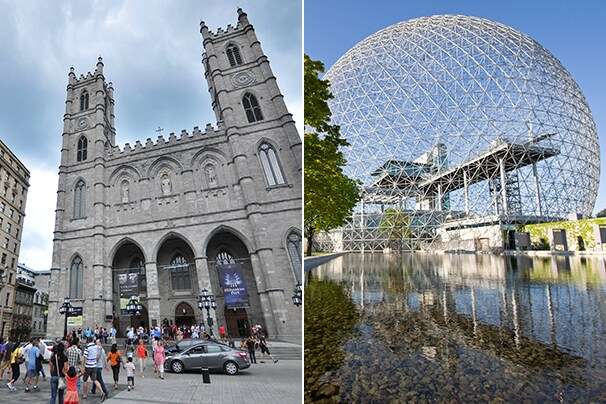In Old Montreal, historical landmarks, European charm and tourists
Modernist masterpieces in Montreal? Mais oui.

A short walk away is the Notre-Dame Basilica, a resplendent Gothic Revival-style church designed by New York architect James O’Donnell and completed in 1829. The soaring, vaulted interiors feature gold-leaf ornamentation, a Casavant Frères pipe organ and stained-glass windows that depict the history of the city. O’Donnell, a Protestant, allegedly converted to Catholicism to be buried there.
Rising 150 feet above the Old Port is the Montreal Clock Tower, built between 1919 and 1922 to commemorate the seamen who died during World War I. In the summer, visitors can climb 192 steps to the top, which offers views of the city’s skyline and the St. Lawrence River.
As atmospheric as the area can be — especially during the warmer months, when cafes overflow onto streets and colorful parasols dot the Clock Tower Beach — the crowds can seriously spoil the mood. And with touristy attractions such as zip lines and haunted houses popping up, you may want to skip Old Montreal altogether and discover some of the city’s other architectural treasures.
Elsewhere in Montreal, relatively unknown modernist masterpieces
In 1967, the six-month-long International and Universal Exposition in Montreal drew about 50 million people to a pair of islands constructed in the St. Lawrence River to display futuristic exhibitions organized around the theme of “Man and His World.”
Gleaming buildings designed by world-renowned architects went up in other parts of the city, and the subway system — a wonder in its own right, with Brutalist stations and public art — was completed just in time for the big event.
Today, most of the expo’s original sites and pavilions have disappeared. But several key landmarks remain. Located within the grounds of Parc Jean-Drapeau on St. Helen’s Island is the Montreal Biosphere, a geodesic dome designed by American architect Buckminster Fuller to serve as the U.S. pavilion. During the expo, the energy-efficient dome housed garden displays and environmental exhibitions; today, it’s a museum that explores themes such as climate change, meteorology and global warming.
Also on the grounds of Parc Jean-Drapeau is the Montreal Casino, which occupies three buildings, two of which are former pavilions from Expo 67. In 2013, a $300 million makeover was completed, and it included a sculpturelike metallic exterior that pays homage to the angular design of the original French pavilion.
One of the most striking interpretations of the expo’s “Man and His World” theme is Habitat 67, a jumble of residential complexes designed by Israeli Canadian architect Moshe Safdie. A utopian vision for urban design, the structure includes 148 residences made up of 354 identical cubes with porthole-like windows and private terraces. During the summer, visitors can take 90-minute guided tours.
Fans of modernist architecture might want to make a pilgrimage to Nuns’ Island to see a gas station designed by architectural master Ludwig Mies van der Rohe. With a sleek roof that offered shelter from the elements, the boxy brick-and-glass structure was held up as a model for service-station design. The building operated as a gas station until 2008; these days, it’s a community center, newly reimagined by architect Éric Gauthier.
Reid is a writer based in New York City. Her website is siobhanreid.com. Find her on Instagram: @siobhanmreid.
PLEASE NOTE
Potential travelers should take local and national public health directives regarding the pandemic into consideration before planning any trips. Travel health notice information can be found on the Centers for Disease Control and Prevention’s interactive map showing travel recommendations by destination and the CDC’s travel health notice webpage.






